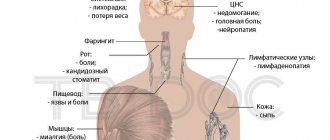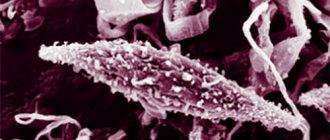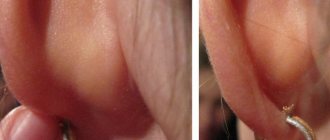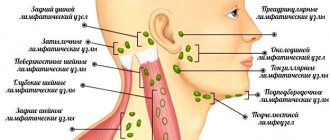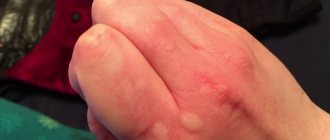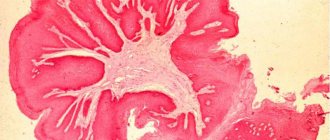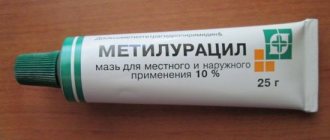Reasons for appearance
Until recently, the main cause of the formation of dermatofibromas was considered to be the body's reaction to insect bites, but now this theory is not officially supported. It has not been determined exactly why such pathologies can occur on the human body . Based on the anamnesis of those suffering from this disease, we can name only probable factors for the development of these neoplasms:
- Genetic predisposition . If one of your close relatives suffered from these skin pathologies, the likelihood of developing dermatofibroma increases.
- Floor . These tumors occur much more often in women than in men.
- Bad ecology . Living in polluted areas - close to major highways, factories and factories, as well as working in hazardous industries can contribute to the development of these pathologies.
- Age . Dermatofibromas mainly affect adults; they are almost never found in children.
- Skin damage . All kinds of injuries, injections and insect bites can contribute to the development of the disease (although this has not been proven for sure).
Dermatofibromas often appear in people who suffer from the following diseases: tuberculosis, acne, chicken pox, liver dysfunction.
Etiology
The exact causes of dermatofibromas have not been established. It is known that they appear more often in women, but are practically not observed in children. It is believed that poor environmental conditions serve as a risk factor for the occurrence of this pathology.
Types of education
There are three types of this skin tumor:
- Dermatofibroma lenticular . It is a cluster of small reddish nodules of a dense structure, each of which is about 1 cm in diameter. Most often, such dermatofibroma is formed as a result of trauma to the skin. Development is slow.
- Dermatofibroma soft consists of soft lobular formations similar to folds. Their sizes vary and their color is yellowish or dark blue. This type of dermatofibroma is localized on the torso or face.
- Hard dermatofibroma consists of many dense lobules of a flesh-colored or reddish hue, their size is about 2 cm in diameter. They can appear on any part of the body and may disappear spontaneously over time.
Find out everything about the causes and treatment of pemphigus after clicking on the link.
How to quickly heal a callus on the heel? This article has the answer!
Types of pathology
Dermatofibroma can easily be confused with a mole or wart due to its external similarity. The root of the nodule extends far into the skin. The formation consists of fibroblasts and histiocytes. If the tumor contains more fibroblasts, dermatofibroma has a type of fibrous elements. An excess of histiocytes indicates a nodule with histiocytic predominance.
There are different types according to their structure:
- Solid dermatofibroma has clear boundaries with a dense body. Found in single and multiple versions. The shape is usually spherical or lobular with a diameter of up to 20 mm. It can dissolve on its own after some time. Color ranges from leathery to dark red.
- The lenticular appearance is formed after trauma to the skin. The color is always red or black. Grows slowly, does not exceed 10 mm. There are two types - single and multiple.
- Soft dermatofibroma grows externally on a stalk with a soft texture and resembles a flabby nodule with an uneven structure. It takes on any color and is found everywhere.
- Fibroxanthoma contains Touton cells with the presence of several nuclei and xanthoma pathogens.
- Sclerosing hemangioma is distinguished by a large number of different vessels and is capable of sclerosing.
Symptoms and diagnosis
Dermatofibroma is characterized by the following features:
- A nodule-shaped compaction appears on the surface of the skin. If damaged, it may bleed.
- When you squeeze the seal with your fingers, it bends inward.
- The color of dermatofibroma is always different from the shade of healthy skin. Most often, this seal is brown or grayish in color, and in rare cases it is black or dark red.
- Touching a dermatofibroma can cause pain and itching.
- Only a small part of the deratofibroma rises above the surface of the skin. Its bulk is located in the skin tissues. To the touch, the seal has a dense structure and a smooth surface. These formations are most often localized on the legs, lower legs, arms and rarely on the torso.
Often, dermatofibroma does not cause any acute discomfort to the sick person. Its development continues for a very long time, sometimes this formation can disappear on its own, or can develop into dangerous malignant tumors.
Attention! It is necessary to visit a doctor at the first signs of this disease, since some types of skin cancer in the initial stages of development show exactly the same symptoms as the relatively harmless dermatofibroma.
Diagnosis of this disease is made through a visual examination of the patient by a doctor. In most cases, a biopsy is prescribed - taking a sample of a small part of the formation and examining it under a microscope. This allows us to identify the potential risk of developing cancerous tumors.
Folk recipes
Folk remedies can help little in the treatment of this disease. Some remedies can only relieve painful symptoms or stop the development of dermatofibroba. The most common recipes are:
- Camphor alcohol. If you cauterize the seals with a cotton swab soaked in camphor alcohol, you can reduce the size of the tumors, and sometimes get rid of them completely. Such procedures may cause a burning sensation in the patient, but there is no need to worry about this - this is just a reaction of deformed skin to alcohol.
- Magnesia. If dermatofibroma has just appeared, magnesium will help get rid of it, which is applied to the sore spot and left for 10-15 minutes. Then you need to rinse it thoroughly with water. can be used instead of magnesium .
- Correct diet. To prevent the development of dermatofibromas and other skin pathologies, it is necessary to eat a fiber-enriched diet. The diet must include a lot of vegetables and a variety of fruits.
Do you know how to treat lichen in humans? Read useful information.
Why do age spots appear on the body? This article has the answer!
After clicking on the link, you can find out everything about the symptoms of demodicosis on the face.
Surgical intervention
Surgical removal of dermatofibroma is prescribed in cases where the lump is located in areas most susceptible to injury, or if it severely spoils a person’s appearance.
Surgery is the only reliable way to get rid of this skin formation once and for all.
The operation itself is quite simple, it does not last long and is completely painless, since it is performed under local anesthesia. If the operation is performed in the morning, the patient is allowed to go home in the evening of the same day.
If surgery was performed correctly, the likelihood of complications or side effects is almost zero. Otherwise, abscesses may occur that will require continued treatment.
Since when removing a dermatofibroma you have to deeply cut the skin, after the operation there will definitely be a scar that will need to be properly cared for. At first it will be very itchy and clearly visible on the body. Gradually, the scar will become less noticeable, but it will never disappear. Half a month after the stitches are removed, measures can be taken to eliminate the scar.
Now there are a huge number of ways to make the scar less noticeable or eliminate it completely.
- The simplest method is to use a special gel that helps keloid scars dissolve. It is recommended to carry out procedures for treating a scar with this gel under the supervision of a professional cosmetologist who knows how to properly apply the gel to the skin and can give useful recommendations for skin care.
- Laser scar removal.
- Surgical removal of the scar. It is prescribed only in cases where the scar is very large and cannot be eliminated by other methods.
- Steroid injections can help reduce the appearance of scars and reduce inflammation.
Consequences of surgical treatment
After surgery to remove dermatofibroma, a scar will always remain; this must be realized. However, modern medicine and cosmetology, in particular, have the necessary arsenal of tools to completely get rid of a postoperative scar. First, you can try to get by with a special gel.
If this does not help, or a faster result is needed, an experienced cosmetologist will excise the scar with a laser. For concomitant therapy, hormonal drugs can be used to reduce inflammatory manifestations.
Modern methods
Nowadays, it is possible to fight dermatofibroma with more progressive methods than surgery. For example, treating a tumor with liquid nitrogen can eliminate the external manifestations of the disease, leaving no scars on the skin. The only disadvantage of this procedure is the likelihood of re-formation of skin growths.
Laser removal has proven itself much better . In one operation, many formations can be eliminated at once. After laser removal, there are almost no noticeable marks left on the skin - only light spots that do not pose a serious cosmetic defect to a person. The main disadvantage of this operation is its fairly high price.
Preventative tips
Since the reasons for the development of this skin pathology have not yet been fully elucidated, there are no specific preventive measures against dermatofibroma.
The only thing that can be advised in this case is to avoid skin damage, as well as treat other skin diseases in a timely manner, monitor your health and follow a proper diet.
It is rarely possible to predict the development of dermatofibroma. In some cases, it disappears on its own, in others it can begin to grow rapidly and lead to serious complications, including malignant tumors. In any case, if the slightest painful symptoms appear, especially bleeding, you should contact a medical facility as soon as possible.
Below is a video in which you can see how to remove dermatofibroma:
Prevention
Due to the unclear etiology of the disease, it is difficult to formulate specific preventive measures. We only know what is needed:
- avoid damage to the skin;
- monitor your diet, get the required amount of vitamins and microelements from food;
- avoid overwork, decreased immunity;
- It is not recommended to expose the body to excessive sun exposure, as this leads to a decrease in immunity.
If you have the slightest doubt or discomfort, do not hesitate to contact a specialist - a dermatovenerologist. Only he will be able to make an accurate diagnosis and prescribe adequate treatment. Any self-medication is always fraught with bad consequences.
Also, it is necessary to remember that this formation in itself does not pose a particular threat and you can calmly live with it all your life. So, the main thing is not to panic.


